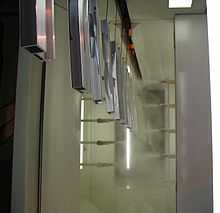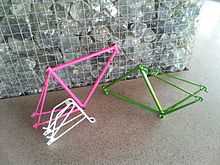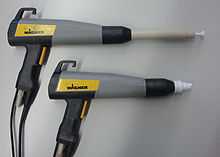Powder coating


Powder coating is a type of coating that is applied as a free-flowing, dry powder. The main difference between a conventional liquid paint and a powder coating is that the powder coating does not require a solvent to keep the binder and filler parts in a liquid suspension form. The coating is typically applied electrostatically and is then cured under heat to allow it to flow and form a "skin". The powder may be a thermoplastic or a thermoset polymer. It is usually used to create a hard finish that is tougher than conventional paint. Powder coating is mainly used for coating of metals, such as household appliances, aluminium extrusions, drum hardware, and automobile and bicycle parts. Newer technologies allow other materials, such as MDF (medium-density fibreboard), to be powder coated using different methods.
Properties of powder coating
Because powder coating does not have a liquid carrier, it can produce thicker coatings than conventional liquid coatings without running or sagging, and powder coating produces minimal appearance differences between horizontally coated surfaces and vertically coated surfaces. Because no carrier fluid evaporates away, the coating process emits few volatile organic compounds (VOC). Finally, several powder colors can be applied before curing them all together, allowing color blending and bleed special effects in a single layer.
While it is relatively easy to apply thick coatings which cure to smooth, texture-free coating, it is not as easy to apply smooth thin films. As the film thickness is reduced, the film becomes more and more orange peeled in texture due to the particle size and glass transition temperature (Tg) of the powder.
Most powder coatings have a particle size in the range of 30 to 50 μm, a softening temperature Tg around 80 °C, a melting temperature around 150 °C, and are cured at around 200 °C.[1] For such powder coatings, film build-ups of greater than 50 μm may be required to obtain an acceptably smooth film. The surface texture which is considered desirable or acceptable depends on the end product. Many manufacturers actually prefer to have a certain degree of orange peel since it helps to hide metal defects that have occurred during manufacture, and the resulting coating is less prone to showing fingerprints.
There are very specialized operations where powder coatings of less than 30 micrometres or with a Tg below 40 °C are used in order to produce smooth thin films. One variation of the dry powder coating process, the Powder Slurry process, combines the advantages of powder coatings and liquid coatings by dispersing very fine powders of 1–5 micrometre particle size into water, which then allows very smooth, low film thickness coatings to be produced.
For garage-scale jobs, small "rattle can" spray paint are less expensive and complex than powder coating. At the professional scale, the capital expense and time required for a powder coat gun, booth and oven are similar to a spray gun system. Powder coatings have a major advantage in that the overspray can be recycled. However, if multiple colors are being sprayed in a single spray booth, this may limit the ability to recycle the overspray.
Types of powder coating
There are two main categories of powder coating: thermosets and thermoplastics. The thermosetting variety incorporates a cross-linker into the formulation. When the powder is baked, it reacts with other chemical groups in the powder to polymerize, improving the performance properties. The thermoplastic variety does not undergo any additional actions during the baking process, but rather only flows out into the final coating.
The most common polymers used are polyester, polyurethane, polyester-epoxy (known as hybrid), straight epoxy (fusion bonded epoxy) and acrylics.
Production:
- The polymer granules are mixed with hardener, pigments and other powder ingredients in a mixer
- The mixture is heated in an extruder
- The extruded mixture is rolled flat, cooled and broken into small chips
- The chips are milled and sieved to make a fine powder
The powder coating process
The powder coating process involves three basic steps:
- Part preparation or the pre-treatment
- The powder application
- Curing
Part preparation processes and equipment
Removal of oil, dirt, lubrication greases, metal oxides, welding scale etc. is essential prior to the powder coating process. It can be done by a variety of chemical and mechanical methods. The selection of the method depends on the size and the material of the part to be powder coated, the type of impurities to be removed and the performance requirement of the finished product.
Chemical pre-treatments involve the use of phosphates or chromates in submersion or spray application. These often occur in multiple stages and consist of degreasing, etching, de-smutting, various rinses and the final phosphating or chromating of the substrate. The pre-treatment process both cleans and improves bonding of the powder to the metal. Recent additional processes have been developed that avoid the use of chromates, as these can be toxic to the environment. Titanium zirconium and silanes offer similar performance against corrosion and adhesion of the powder.
In many high end applications, the part is electrocoated following the pretreatment process, and subsequent to the powder coating application. This has been particularly useful in automotive and other applications requiring high end performance characteristics.
Another method of preparing the surface prior to coating is known as abrasive blasting or sandblasting and shot blasting. Blast media and blasting abrasives are used to provide surface texturing and preparation, etching, finishing, and degreasing for products made of wood, plastic, or glass. The most important properties to consider are chemical composition and density; particle shape and size; and impact resistance.
Silicon carbide grit blast medium is brittle, sharp, and suitable for grinding metals and low-tensile strength, non-metallic materials. Plastic media blast equipment uses plastic abrasives that are sensitive to substrates such as aluminum, but still suitable for de-coating and surface finishing. Sand blast medium uses high-purity crystals that have low-metal content. Glass bead blast medium contains glass beads of various sizes.
Cast steel shot or steel grit is used to clean and prepare the surface before coating. Shot blasting recycles the media and is environmentally friendly. This method of preparation is highly efficient on steel parts such as I-beams, angles, pipes, tubes and large fabricated pieces.
Different powder coating applications can require alternative methods of preparation such as abrasive blasting prior to coating. The online consumer market typically offers media blasting services coupled with their coating services at additional costs.
Powder application processes

The most common way of applying the powder coating to metal objects is to spray the powder using an electrostatic gun, or corona gun. The gun imparts a positive electric charge to the powder, which is then sprayed towards the grounded object by mechanical or compressed air spraying and then accelerated toward the workpiece by the powerful electrostatic charge. There are a wide variety of spray nozzles available for use in electrostatic coating. The type of nozzle used will depend on the shape of the workpiece to be painted and the consistency of the paint. The object is then heated, and the powder melts into a uniform film, and is then cooled to form a hard coating. It is also common to heat the metal first and then spray the powder onto the hot substrate. Preheating can help to achieve a more uniform finish but can also create other problems, such as runs caused by excess powder. See the article "Fusion Bonded Epoxy Coatings"
Another type of gun is called a tribo gun, which charges the powder by (triboelectric) friction. In this case, the powder picks up a positive charge while rubbing along the wall of a Teflon tube inside the barrel of the gun. These charged powder particles then adhere to the grounded substrate. Using a tribo gun requires a different formulation of powder than the more common corona guns. Tribo guns are not subject to some of the problems associated with corona guns, however, such as back ionization and the Faraday cage effect.
Powder can also be applied using specifically adapted electrostatic discs.
Another method of applying powder coating, called the fluidized bed method, is by heating the substrate and then dipping it into an aerated, powder-filled bed. The powder sticks and melts to the hot object. Further heating is usually required to finish curing the coating. This method is generally used when the desired thickness of coating is to exceed 300 micrometres. This is how most dishwasher racks are coated.
Dry powder coating of particles was performed using a Cyclomix impact mixer, allowing to change the properties of host powders.[2] Furthermore, the simulated approach was successfully compared to the experimental one.[3] Nara hybridizer was also used for dry coating process.[4]
Electrostatic fluidized bed coating
Electrostatic fluidized bed application uses the same fluidizing technique and the conventional fluidized bed dip process but with much less powder depth in the bed. An electrostatic charging medium is placed inside the bed so that the powder material becomes charged as the fluidizing air lifts it up. Charged particles of powder move upward and form a cloud of charged powder above the fluid bed. When a grounded part is passed through the charged cloud the particles will be attracted to its surface. The parts are not preheated as they are for the conventional fluidized bed dip process.
Electrostatic magnetic brush (EMB) coating
A coating method for flat materials that applies powder with a roller, enabling relative high speeds and accurate layer thickness between 5 and 100 micrometre. The base for this process is conventional copier technology. Currently in use in some coating applications and promising for commercial powder coating on flat substrates (steel, aluminium, MDF, paper, board) as well in sheet to sheet and/or roll to roll processes. This process can potentially be integrated in an existing coating line.
Curing
When a thermoset powder is exposed to elevated temperature, it begins to melt, flows out, and then chemically reacts to form a higher molecular weight polymer in a network-like structure. This cure process, called crosslinking, requires a certain temperature for a certain length of time in order to reach full cure and establish the full film properties for which the material was designed. Normally the powders cure at 200 °C (390 °F) for 10 minutes. The curing schedule could vary according to the manufacturer's specifications. The application of energy to the product to be cured can be accomplished by convection cure ovens, infrared cure ovens, or by laser curing process. The latter demonstrates significant reduction of curing time.
Removing powder coating
Methylene chloride and acetone are generally effective at removing powder coating, however most other organic solvents (thinners, etc.) are completely ineffective. Most recently the suspected human carcinogen methylene chloride is being replaced by benzyl alcohol with great success. Powder coating can also be removed with abrasive blasting. 98% sulfuric acid commercial grade also removes powder coating film. Certain low grade powder coats can be removed with steel wool, though this might be a more labor-intensive process than desired. Powder coating can also be removed by a burning off process, in which parts are put into a large high-temperature oven with temperatures typically reaching an air temp of 1100 to 1500 degrees with a burner temperature of 900. The process takes about four hours and requires the parts to be cleaned completely and repowdered. Parts made with a thinner-gauge material need to be burned off at a lower temperature to prevent the material from warping.
Market
In 2010, the global demand for powder coatings amounts to approximately US$5.8 billion. Driven by the development of new material, new formulations and advancement of equipment and application processes, the powder coating market presents a rapid annual growth of around 6% from 2012 to 2018. Currently, the industrial uses are the largest application market of powder coatings. Automotive industry experiences the most dynamic growth. Steady and strong growth is also expected by furniture and appliance markets. Furthermore, the application of powder coatings in IT & Telecommunication is also being widely explored.[5]
See also
- Laser printer
- Fusion bonded epoxy coating
- Sandblasting
References
- ↑ DSM Coating Resins (October 2004). "Enlarging the Cure Window of Powder Coatings". Paint & Coatings Industry.
- ↑ Ouabbas Y, Dodds J., Galet L., Chamayou A. , Baron M., Particle-particle coating in a cyclomix impact mixer, Powder Technol., 189 (2009), 245-252
- ↑ Sato A., Serris E., Grosseau P., Thomas G., Galet L., Chamayou A. , Baron M., Experiment and simulation of dry particle coating, Chem. Eng. Science, 86 (2013), 164-172
- ↑ Thomas G., Ouabbas Y., Grosseau P., Baron M., Chamayou A., Galet L., Modeling the main interaction forces between powder particles. Application to silica gel-magnesium stearate mixtures, Applied Surface Science, 255 (2009), 7500-7507
- ↑ "Market Report: Global Powder Coating Market". Acmite Market Intelligence.